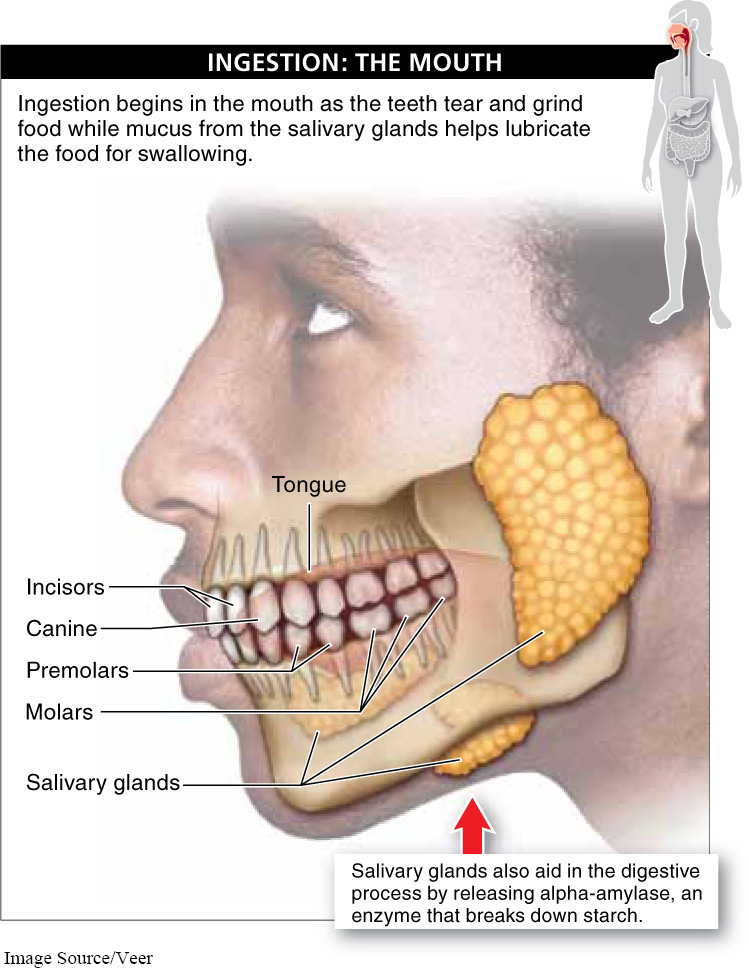
It will take you longer to read about ingestion, the intake of food into your body, than it would to just do it (FIGURE 22-17). Typically lasting less than a minute, ingestion primarily involves four parts of your anatomy: your mouth, teeth, tongue, and esophagus. We’ll look at each in some detail. To start, imagine that you take a big bite of a hamburger, containing bread, lettuce, and the meat.
Putting food in your mouth stimulates your salivary glands. (In fact, just thinking about food can stimulate saliva secretion!) Via tiny ducts throughout your mouth, the salivary glands secrete mucus that lubricates the food to help it pass into your stomach. They also secrete an enzyme called alpha-
Humans use heat for cooking and often marinate foods in vinegar or lemon juice. How do these processes help with digestion?
Interestingly, across dozens and dozens of cultures, humans have developed common ways of preparing their food, including using heat and marinating food in acidic solutions, such as vinegar or lemon juice. Because harsh conditions such as heat and acid help to disrupt the tissue of food items, they increase the efficiency with which digestive enzymes can make contact with the food and break it down.
You start chewing food in your mouth in order to tear and grind it into little bits. This is a first important step toward completely breaking down and harvesting the energy stored in the chemical bonds of the food. Several different types of teeth have evolved in mammals and other animal species that allow different types of food items to be processed. Incisor and canine teeth, in the front, are used for biting and tearing food. Behind them are premolars and molars, used for grinding and crushing food. Just by looking at the type of teeth an animal has, we can learn a lot about its diet. Herbivores have molars primarily for grinding and crushing the tough cell walls of the plants they eat. Carnivores have sharp and lethal canines and incisors for killing and tearing apart the flesh of other animals.
Why do many birds eat gravel?
Birds have no teeth. This explains why they can sometimes be seen eating gravel. Although the gravel has no nutritional value, it collects in the gizzard, one of the two chambers of their stomach, where it helps to grind up food. This is an important digestive step for birds because, lacking teeth, they must swallow their food whole. Consequently, when it first arrives in the stomach, the food hasn’t been ground up at all, which can reduce the efficiency of digestive enzymes.

While you are chewing your food, your tongue assists in the process by forming the food into a ball shape that can be swallowed. The ball of partly crushed, saliva-
890
Once the ball of chewed food makes its way into the esophagus, waves of smooth muscle contractions, called peristalsis, propel the food down the esophagus and into the stomach, where digestion continues. Because of peristalsis, it’s not necessary for you to be sitting upright or standing when you eat. Even if you are standing on your head, the food is pushed down the esophagus to the stomach.
TAKE-HOME MESSAGE 22.9
Ingestion is the first phase of the digestive process. Usually lasting less than a minute, ingestion involves tearing and grinding food in preparation for passing it to the stomach. Digestion also begins during this phase, with some starch being broken down by enzymes in saliva.
Ingestion occurs within an individual's mouth. Describe what happens during ingestion from the point the food enters the mouth to the point it is swallowed.
Ingestion consists of taking the food into the mouth as well as using teeth to mechanically break down the food. The salivary enzyme alpha-amylase begins digestion in the mouth by breaking down some of the starch. The muscular tongue then forms food into a ball that can be swallowed.